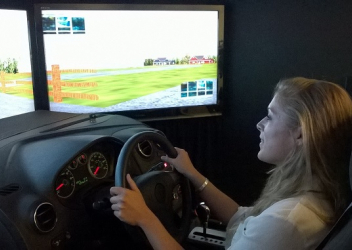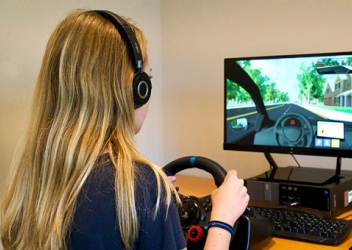Simulated Driving Assessment
The CIRP Teen Driving Safety Research team has developed an understanding of how serious teen driver crashes occur, including the typical scenarios and factors that contribute to these crashes. However, no validated test, grounded in this understanding of how teens crash, was available to assess whether a teen was prepared to drive safely during the learner period. Researchers at CHOP and the University of Pennsylvania created the Simulated Driving Assessment to meet this need, offering for the first time a safe way to assess novice teen drivers' skill levels in actual crash scenarios.
Led by Flaura K. Winston, MD, PhD, and Catherine C. McDonald, PhD, RN and funded bv the Pennsylvania Department of Health and National Institute of Nursing Research of the NIH, the systematic development of the Simulated Driving Assessment was grounded in epidemiologic research of how teens and adults crash and in validated metrics for safe and unsafe driving in real-world situations.
In 2016, this software technology spun out as an independent company called Diagnostic Driving, Inc., which is partnering with CIRP and the Ohio Department of Public Safety to pilot and fully implement Ready-Assess™ software as the Ohio Portable Driving Simulator System (PDSS) in the Ohio Bureau of Motor Vehicles licensing centers.
Validation Research
Research published in Injury Prevention demonstrated the validity of the Simulated Driving Assessment for safe evaluation of novice teen driver skill in high-risk driving scenarios:
- During the Simulated Driving Assessment, nearly 43% of newly licensed teens (within three months of licensure) had a simulated crash at least once. For licensed, experienced adult drivers, that percentage was 29%.
- For every additional error committed during the Simulated Driving Assessment, the risk for crashing or running off the road increased by 8%.
- Although the novice teen drivers were adept at basic driving skills (i.e., using turn signals), the more advanced skills (i.e., braking in hazardous situations, anticipating and responding to hazards) proved challenging.
Foundational Research
The following studies contributed to the validation of the Simulated Driving Assessment:
- Comparison of Adult and Teen Driver Crash Scenarios in a Nationally Representative Sample of Serious Crashes. Annals of Advancement in Automotive Medicine. September 2013.
- Using Crash Data to Develop Simulated Scenarios for Assessing Novice Driver Performance.Transportation Research Record. July 2014.
- Experience and Skill Predict Failure to Brake Errors: Further Validations of the Simulated Driving Assessment. SAE Technical Paper. April 2014.
- Simulated Driving Assessment: Case Study for the Development of Drivelab, Extendable Matlab™ Toolbox for Data Reduction of Clinical Driving Simulator Data. SAE Technical Paper. April 2014.
- Simulated Driving Assessment for Teen Drivers: Results from a Validation Study. Injury Prevention. March 2015.






